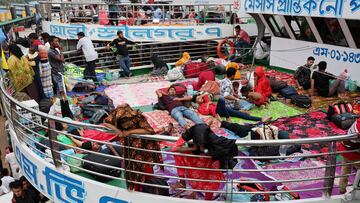RAMADAN
What is Eid al-Fitr, the last day of Ramadan 2024 and how is it celebrated?
As Ramadan comes to an end once again, millions of people around the world will be prepared for the final day and all that goes with it.

Have you been involved, directly or indirectly, with Ramadan this year? Well, if you have, you’ll more than likely be prepared for it coming to its annual end, with Eid al-Fitr. This festival of breaking the fast, officially marks the end of Ramadan, the Islamic holy month of fasting. This joyous occasion is celebrated by Muslims around the world, including communities in the United States. As Eid al-Fitr 2024 arrives, let’s delve into the significance of this day and explore the traditions and customs associated with it.
What is Eid al-Fitr and what is its significance?
Eid al-Fitr, often referred to simply as Eid, is one of the most significant festivals in Islam. It falls on the first day of Shawwal – the 10th month of the Islamic (Hijri) calendar – the month following Ramadan, and marks the end of a month-long period of fasting, prayer, reflection, and community.
Eid al-Fitr holds great spiritual significance for Muslims. It is a time of gratitude, forgiveness, and compassion. It symbolizes the breaking of the fast and the renewal of spiritual devotion. Additionally, Eid al-Fitr is an occasion for Muslims to express their joy and gratitude to Allah for giving them the strength to observe fasting during Ramadan.
How is Eid al-Fitr celebrated?
Eid al-Fitr is celebrated with great enthusiasm and joy by Muslims worldwide. The festivities typically begin with a special prayer known as the Eid Salah, performed in congregation at mosques or open prayer grounds. The prayer is followed by a sermon, where the imam addresses the community, emphasising the significance of Eid and its teachings.
One of the hallmark features of Eid al-Fitr is the emphasis on family and community. After the Eid prayer, families gather for a festive meal known as “Eid breakfast” or “Eid brunch,” where traditional dishes are enjoyed together. It is also common for Muslims to visit relatives, friends, and neighbours, exchanging greetings and gifts.
Another important aspect of Eid al-Fitr is the emphasis on charity and generosity. Muslims are encouraged to give to those in need, particularly during Eid, through the giving of Zakat al-Fitr, a form of charity given before the Eid prayer. This ensures that everyone in the community can participate in the celebrations and enjoy the festivities.
Eid al-Fitr is a time of feasting and festivities. Special dishes and sweets are prepared to mark the occasion, with each culture and region having its own unique culinary traditions. Popular dishes include biryani, kebabs, samosas, and various desserts such as baklava, kunafa, and sheer khurma.






